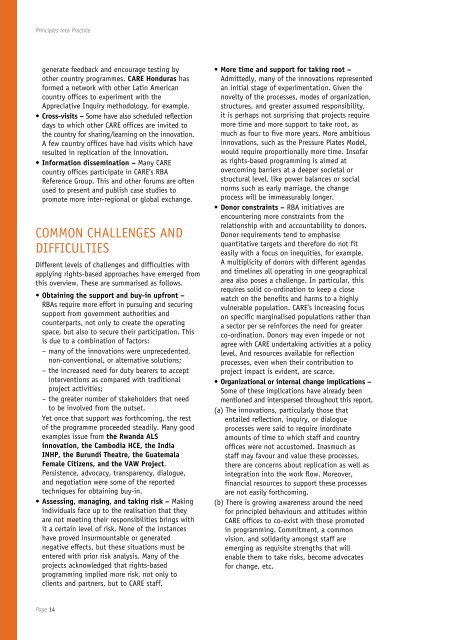Principles into Practice - Handicap International
Principles into Practice - Handicap International
Principles into Practice - Handicap International
- No tags were found...
Create successful ePaper yourself
Turn your PDF publications into a flip-book with our unique Google optimized e-Paper software.
<strong>Principles</strong> <strong>into</strong> <strong>Practice</strong>generate feedback and encourage testing byother country programmes. CARE Honduras hasformed a network with other Latin Americancountry offices to experiment with theAppreciative Inquiry methodology, for example.• Cross-visits – Some have also scheduled reflectiondays to which other CARE offices are invited tothe country for sharing/learning on the innovation.A few country offices have had visits which haveresulted in replication of the innovation.• Information dissemination – Many CAREcountry offices participate in CARE’s RBAReference Group. This and other forums are oftenused to present and publish case studies topromote more inter-regional or global exchange.COMMON CHALLENGES ANDDIFFICULTIESDifferent levels of challenges and difficulties withapplying rights-based approaches have emerged fromthis overview. These are summarised as follows.• Obtaining the support and buy-in upfront –RBAs require more effort in pursuing and securingsupport from government authorities andcounterparts, not only to create the operatingspace, but also to secure their participation. Thisis due to a combination of factors:– many of the innovations were unprecedented,non-conventional, or alternative solutions;– the increased need for duty bearers to acceptinterventions as compared with traditionalproject activities;– the greater number of stakeholders that needto be involved from the outset.Yet once that support was forthcoming, the restof the programme proceeded steadily. Many goodexamples issue from the Rwanda ALSinnovation, the Cambodia HCE, the IndiaINHP, the Burundi Theatre, the GuatemalaFemale Citizens, and the VAW Project.Persistence, advocacy, transparency, dialogue,and negotiation were some of the reportedtechniques for obtaining buy-in.• Assessing, managing, and taking risk – Makingindividuals face up to the realisation that theyare not meeting their responsibilities brings withit a certain level of risk. None of the instanceshave proved insurmountable or generatednegative effects, but these situations must beentered with prior risk analysis. Many of theprojects acknowledged that rights-basedprogramming implied more risk, not only toclients and partners, but to CARE staff.• More time and support for taking root –Admittedly, many of the innovations representedan initial stage of experimentation. Given thenovelty of the processes, modes of organization,structures, and greater assumed responsibility,it is perhaps not surprising that projects requiremore time and more support to take root, asmuch as four to five more years. More ambitiousinnovations, such as the Pressure Plates Model,would require proportionally more time. Insofaras rights-based programming is aimed atovercoming barriers at a deeper societal orstructural level, like power balances or socialnorms such as early marriage, the changeprocess will be immeasurably longer.• Donor constraints – RBA initiatives areencountering more constraints from therelationship with and accountability to donors.Donor requirements tend to emphasisequantitative targets and therefore do not fiteasily with a focus on inequities, for example.A multiplicity of donors with different agendasand timelines all operating in one geographicalarea also poses a challenge. In particular, thisrequires solid co-ordination to keep a closewatch on the benefits and harms to a highlyvulnerable population. CARE’s increasing focuson specific marginalised populations rather thana sector per se reinforces the need for greaterco-ordination. Donors may even impede or notagree with CARE undertaking activities at a policylevel. And resources available for reflectionprocesses, even when their contribution toproject impact is evident, are scarce.• Organizational or internal change implications –Some of these implications have already beenmentioned and interspersed throughout this report.(a) The innovations, particularly those thatentailed reflection, inquiry, or dialogueprocesses were said to require inordinateamounts of time to which staff and countryoffices were not accustomed. Inasmuch asstaff may favour and value these processes,there are concerns about replication as well asintegration <strong>into</strong> the work flow. Moreover,financial resources to support these processesare not easily forthcoming.(b) There is growing awareness around the needfor principled behaviours and attitudes withinCARE offices to co-exist with those promotedin programming. Commitment, a commonvision, and solidarity amongst staff areemerging as requisite strengths that willenable them to take risks, become advocatesfor change, etc.Page 14

















